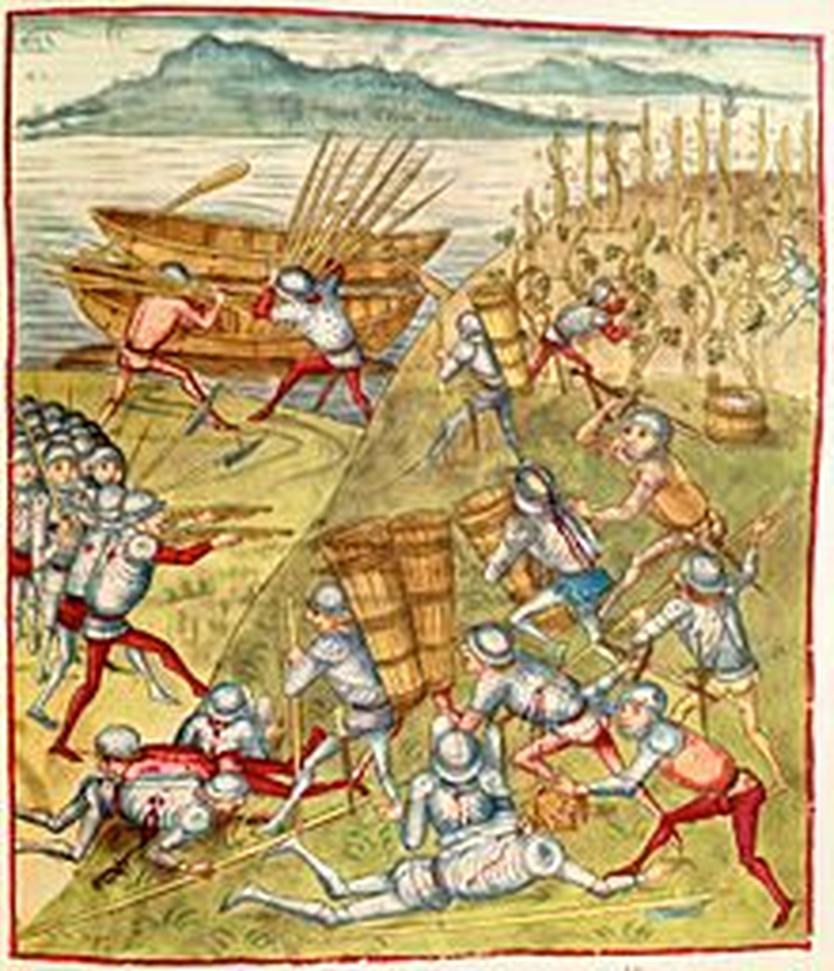Firing an early 16th century arquebus involves a noticeable recoil similar to a modern shotgun. The weapon’s heavy barrel and stock reduce recoil force, and it typically requires a rest to steady it during firing. The firing position is mostly stationary due to the stand carried with the gun. Upon firing, one encounters heavy white smoke from black powder, as smokeless powder was not introduced until the late 19th century.
The trigger mechanism operates differently from modern firearms. The serpentine, shaped like a lever, holds a burning match cord that ignites the powder in the flashpan. Pulling the trigger lowers the serpentine, but ignition timing remains uncertain. If the match is too far from the flashpan, the powder may not ignite, making the arquebus challenging to use reliably. Experience is essential to time the shot correctly.
Loading the arquebus is a detailed process. Soldiers carried powder bottles and shot pouches separately—coarse powder for the barrel, fine powder for the flashpan. These were often carried on belts, called “the twelve apostles,” containing twelve individual powder charges. The user poured powder into the barrel, followed by a lead ball from the bullet pouch. They rammed the ball and powder down tightly with a patch to seal the charge.
Next, they primed the flashpan with fine powder and slid a pan cover over it to protect it from wind and movement. The match cord was placed in the serpentine’s jaws. Firing involved pulling the trigger, dropping the serpentine and match onto the flashpan to ignite the primer, which then fired the main charge in the barrel.
Maintenance was crucial to keep the arquebus functional. After firing, soldiers cleaned out the barrel to remove fouling—a sticky residue left by black powder—using hot water and rags. Oil or grease was applied both inside and outside the barrel to prevent rust. Due to the heavy use and residue from black powder, regular cleaning was mandatory to maintain reliability and accuracy.
The process of loading and firing, while detailed, could become rapid with experience. Although early manuals list over thirty steps, many are small actions combined into fluid motions. In practice, an experienced arquebusier might complete the load, prime, and fire cycle in about 30 seconds. This speed is slower than 18th or 19th-century soldiers trained with flintlock muskets, who fired every 20 seconds, but it still allowed effective battlefield use. Within two minutes to reload and fire was considered extremely slow for a practiced user.
| Aspect | Details |
|---|---|
| Recoil | Noticeable, less than modern shotgun due to heavy barrel and stock |
| Smoke | Heavy, white smoke from black powder |
| Trigger Mechanism | Serpentine lever holding match cord; ignition timing unpredictable |
| Loading Steps | Pour powder, add ball and patch, ram down, prime flashpan, cover pan, place match, fire |
| Maintenance | Cleaning fouling with hot water, applying oil to prevent rust |
| Fire Rate | About 30 seconds for experienced arquebusier |
- The arquebus fires with noticeable recoil but is steadied by its weight and use of a rest.
- Black powder creates heavy smoke and fouling requiring frequent cleaning.
- The serpentine trigger is mechanically simple but requires skill to ensure ignition.
- Loading involves many precise steps but can be done in about 30 seconds by an expert.
- Regular maintenance is critical to keep the weapon in working order.
What Does It Feel Like to Fire an Early 16th Century Arquebus?

Firing an early 16th century arquebus is a decidedly hands-on, smoky, and somewhat unpredictable event, best imagined as hefting a heavy, slow-acting shotgun with a temperamental trigger and an insistence on lots of smoke. The arquebus isn’t a modern rifle; it demands patience, skill, and a good appreciation for messy black powder.
The moment you pull the trigger, you feel a *noticeable* recoil, though it doesn’t launch the gun out of your hands. It’s kind of like a modern shotgun blast, firm but manageable—especially since these guns are hefty. Made with thick barrels and solid stocks, the arquebus’ weight helps tame the kick. Soldiers often rested the barrel on the ground or some support to steady their aim. This means firing from a standing position with a rest—not the quick, fluid motion you might picture.
And then there’s the smoke. Imagine lighting a campfire under a still day and then being engulfed in a cloud. That’s black powder ignition for you. Early 16th-century arquebuses create thick white smoke with every shot. The combustion of black powder is dirty, and visibility quickly drops on the battlefield. This smoke wasn’t just a nuisance—it sometimes affected aiming and gave away positions.
The trigger mechanism itself is quirky. Unlike modern firearms with precise click-and-fire triggers, early arquebuses use a serpentine—a lever holding a glowing matchcord. When you squeeze the trigger, the serpentine drops and brings the lit match to the powder-filled flash pan. But here’s the catch: the ignition timing isn’t exact. If the match is too short or long, it might not ignite the powder right away—or even miss it entirely. For this reason, shooting an arquebus isn’t just about pulling the trigger; it’s a delicate operation requiring experience and timing.
The Loading Ballet: A Dance of 30+ Steps

Loading and firing an arquebus is more choreographed than most realize. According to Jacob De Gheyn’s meticulous 16th century manual The Exercise of Armes, the entire process involves over thirty individual steps. Don’t let the number scare you—they include tiny adjustments and checks, crucial to success.
- You start by pouring powder—usually from a coarse grain bottle—down the barrel.
- Next, you drop a lead ball from the bullet bag into the barrel.
- A cloth patch goes in to keep everything tight together.
- Then, a ramrod presses the patch, ball, and powder firmly down.
- Now, you prime the flash pan with fine powder from a separate flask to ensure it ignites quickly.
- You slide the pan cover over to protect the priming powder from wind and rain.
- Finally, the primed matchcord is placed securely in the serpentine jaws, readying the weapon for firing.
Soldiers typically carried multiple pre-loaded powder bottles and spent a lot of time tending their gear. The famous “twelve apostles” belt, for example, held a dozen powder charges, bullet pouches, and priming flasks, allowing quick reloads in the heat of battle.
Time Is of the Essence: Loading and Firing Speed

So, how fast can someone fire one? For an experienced arquebusier—think trained soldier, drilled and steady—the whole loading, priming, and firing cycle could be squeezed into roughly 30 seconds. That’s impressive considering the number of precise steps required.
Two minutes per shot is an exaggeration—probably for very inexperienced users. By contrast, careful practice turns this complex ritual into a fluid routine. Still, it’s no rapid-fire machine. Soldiers of the 18th and 19th centuries managed to shrink that pace further to about 20 seconds per round, benefiting from improved designs and tactics.
Maintaining the Weapon: Behind the Scenes Work

Firing an arquebus wasn’t just about shooting—maintenance was a battlefield necessity. Black powder quickly fouled the barrel, leaving behind a sticky residue that could jam the weapon. Soldiers cleaned their pieces with hot water and oiled cloths, removing fouling and protecting metal parts from rust.
Applying grease or oil inside and out helped preserve the weapon. In the damp conditions of campaign life, this upkeep mattered. Neglect a cleaning, and your piece would misfire at the worst moment.
What’s It Like to Hold and Fire a Real Early 16th Century Arquebus?
Imagine hefting 10 to 15 pounds of solid wood and metal, lugging a stand, and carefully juggling powder flasks and bullets. The arquebus is serious business, demanding a blend of strength, precision, and patience. The recoil hits firmly but is softened by the gun’s weight and your support stand. Light a matchcord and wait for the moment when you pull the trigger—a moment tinged with uncertainty because you never know exactly when the powder will ignite.
After the bang and thick cloud of smoke, you’re immediately faced with cleaning and reloading, rehearsing the same ritual dozens of times throughout battle. This isn’t a weapon for the impatient. It is a tool that rewards practice, discipline, and calm nerves.
Why Should You Care?
The arquebus reflects an era when early firearms were reshaping warfare, challenging centuries of tradition. Learning how it feels to fire one gives insight into the lives of soldiers who operated under smoky, noisy, and risky conditions.
If you ever find yourself at a historical reenactment or museum demonstration and get a chance to handle or fire an arquebus replica, brace for a heavy, smoky blast and a waiting game with that temperamental matchlock trigger. It’s a vivid reminder of how far firearms technology has come—and how demanding early gunpowder warfare really was.
In Closing: Key Takeaways
- Hefty recoil: Comparable to a modern shotgun but controlled by weight and a firing rest.
- Messy ignition: Thick clouds of white smoke after every shot.
- Complex loading: Over 30 detailed steps from powder to patch to matchcord placement.
- Slow but steady: Firing once every 30 seconds is achievable for practiced soldiers.
- Maintenance matters: Regular cleaning and oiling prevent misfires and corrosion.
If you’re hungry for deep detail, explore texts like Jacob De Gheyn’s The Exercise of Armes or Alan Williams’ The Knight and the Blast Furnace, which decode the technical and practical challenges of early firearms.
So, ready to trade your sleek modern rifle for a smoky, clunky arquebus? Brace yourself—it’s a wild ride back to the dawn of gunpowder warfare.
What does it feel like to fire an early 16th century arquebus?
Firing an arquebus produces noticeable recoil, similar to a modern shotgun. It’s heavy, so recoil is eased by resting it on a support. Expect thick white smoke after each shot due to black powder use.
How do you load and prepare an arquebus for firing?
- Pour coarse powder down the barrel.
- Drop a bullet on top, then ram it all down with a patch.
- Prime the flash pan with finer powder and slide the pan cover closed.
- Place the lit match cord in the serpentine jaws.
What is the firing mechanism like on an arquebus?
The trigger moves a lever called the serpentine, dropping the lit match into the flash pan. There’s no spring release, so timing the ignition can be tricky and requires skill.
How long does it take to load and fire for someone experienced?
An expert arquebusier could reload and fire in about 30 seconds. Two minutes would be unusually slow. Many detailed steps can be done swiftly with practice.
What maintenance is needed after firing the arquebus?
After shooting, the barrel is cleaned with hot water to remove fouling. Grease or oil is applied inside and outside to prevent rust. This keeps the weapon reliable for the next use.



